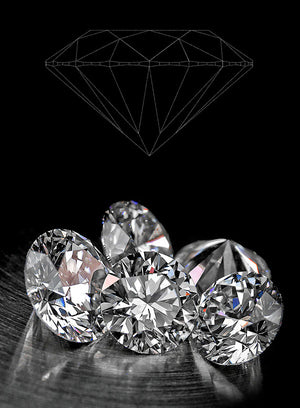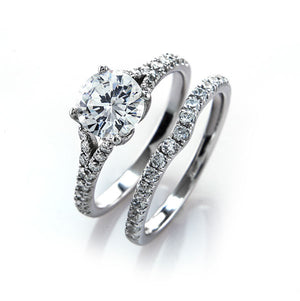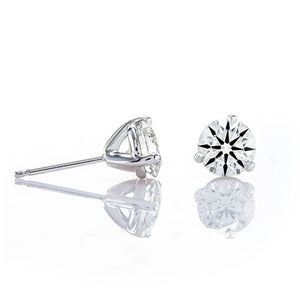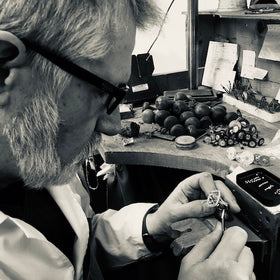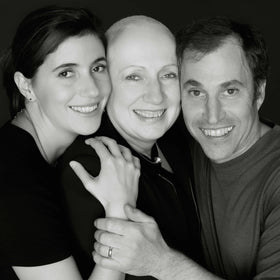
There are a lot of diamond vendors offering "ideal cut diamonds" and "super ideal cut diamonds" on the internet, however there is only one Brian Gavin; and as a fifth generation diamond cutter, Brian Gavin has the experience and expertise to create diamonds that deliver an incredible volume of light return and sparkle factor, we're talking about a level of visual performance that is second to none!
The modern round brilliant cut diamond:
Throughout the years, the round brilliant cut diamond has become the symbol of love that adorns the majority of diamond engagement rings; the modern round brilliant cut diamond is the most popular of all diamond shapes, it has enjoyed the spot light of center stage, on the opening night of more marriage proposals, than any other shape of diamond; and is most often set in a traditional solitaire setting, like this Classic knife edge style solitaire by Brian Gavin. The modern round brilliant cut diamond has withstood the test of time, however it is constantly being improved.
It is common knowledge that even the best of consumer products and services are available in a wide variety of quality; there are substantial differences to be found between the quality of high end automobiles such as Audi, BMW, Ferrari, Lamborghini, Lexus, and Porsche to name a few; just as there are differences between "5 Star Hotels" and "Luxury Brands" of every sort.
In the world of round brilliant cut diamonds, there exists a wide variety of diamond cut quality, which is defined and measured by specific criteria that take the proportions of the diamond into account, as well as the diamond polish and symmetry grades.
The American Gem Society Laboratory (AGSL) takes things one-step further, by grading diamonds for Light Performance as part of their grading standard. This is an important factor, since the overall degree of diamond cut quality can affect the market value of a diamond by as much as sixty percent!
Brian Gavin Signature Hearts & Arrows diamonds:

The one factor that the majority of diamond grading laboratories fail to take into account, is the degree of optical precision exhibited by the diamonds that are submitted to them for grading; and this is a real shame, since optical symmetry is the three dimensional consistency of facet shape and alignment, it is a major influence upon the sparkle factor of a diamond!
Hearts and Arrows diamonds deliver best visual performance:

The hearts and arrows cut diamond was first developed in the 1980s by Japanese cutters, who set out to produce the worlds most perfectly cut diamond. These diamond cutters had discovered that patterns of hearts and arrows were created within a round brilliant cut diamond, by the overlapping of virtual facets and reflections created within a diamond by the basic facet structure, when the facets are polished upon the surface of the diamond with incredible consistency, and when the facets are indexed from one to the next with extreme precision.
"Hearts and Arrows diamonds" became popular primarily because they exhibit a crisp and complete pattern of eight "hearts" and eight "arrows" when the diamond was viewed through a special scope that was developed by the Japanese for the purpose of judging diamond cut quality.
This visual phenomenon that is created by the kaleidoscope effect of facet reflections being projected from one side of the diamond, on to the facets located on the other side of the diamond, was nicknamed the "Cupid effect," and these diamonds became known in the trade as "hearts and arrows diamonds".
The effect of Optical Precision upon a diamond:
The term "Optical Precision" is used to describe the precision of facet shape, alignment, and indexing. The degree of optical precision of a diamond must be exceptional for a crisp and complete pattern of hearts and arrows to appear when the loose diamond is evaluated through a Hearts and Arrows grading scope.
The special reflector scope that was developed to make it possible for the patterns of hearts and arrows within a diamond to be viewed, magnifies the image of the diamond, and uses a combination of filtered light and white disks, to create the separations of white and red colors within the diamond, that make it possible to gauge the consistency that the facet structure of the diamond has been cut to.
Any variation in the facet structure of the diamond, or in the alignment, or indexing of the facets, will be magnified when the diamond is viewed through the reflector scope, and will be readily apparent in the form of irregular or misshapen hearts, bending or twisting of the tips of the hearts, split clefts at the top of the hearts, or edges of hearts that bleed into the arrowheads that appear in the center region of the diamond.
Why Brian Gavin says "It's all in the hearts"
As with most things, once hearts and arrows diamonds became popular with online diamond buyers, the concept of what defines a "hearts and arrows cut diamond" and what is not a true hearts and arrows cut diamond began to get distorted; as diamond dealers who were not really familiar with how hearts patterns are created within a round brilliant cut diamond, began to promote the idea that any round brilliant cut diamond, that is cut to ideal proportions, will exhibit a crisp and complete pattern of hearts and arrows.
However all it takes to disprove this theory is to take just about any round brilliant ideal cut diamond with an overall cut grade of either GIA Excellent or AGS Ideal, and throw it under a hearts and arrows scope, to determine whether it exhibits a crisp and complete pattern of hearts and arrows or not.
In most cases, we think you'll discover that upon close examination, the majority of round brilliant ideal cut diamonds exhibit some sort of distorted hearts pattern, which more often than not looks more like rabbit ears, or lawn darts, than it does hearts; and this is because the diamonds feature the same facet structure, however it is the consistency of angles, facet shape, alignment, and indexing that determines whether the pattern created by light reflecting through the diamond will be "hearts and arrows" or just some strange kaleidoscope induced pattern of random imagery.
The only way to judge the degree of optical precision that a diamond has been cut to, is to carefully evaluate the hearts pattern as seen through a Hearts & Arrows Scope, and this is why Brian Gavin says "It's all in the hearts".
Brian Gavin, the standard of excellence for H&A diamonds:
Although Brian Gavin did not invent the Hearts and Arrows cut diamond, he has been a major influence in developing and promoting the "Hearts and arrows diamond grading standards" that are used by the upper echelon of the diamond industry.
Because of his expertise in the planning and cutting of Hearts and Arrows quality diamonds, Brian Gavin was asked to speak at the International Diamond Cut Conference, which was held in Moscow, Russia in April of 2004; the topic of the speech that Brian Gavin presented at the conference was "Hearts and Arrows (diamonds) how they are formed, and how they should be graded" and was based upon research that he conducted between the years 1999 and early 2000.
Other speakers at the International Diamond Cut Conference of 2004 included industry greats like Gabi Tolkowskyheir to the legacy created by the publication of Marcel Tolkowsky's book "Diamond Design" which popularized the concept of "the ideal cut diamond" back in 1919; Ma arten DeWitte; representatives of the American Gem Society Laboratory (AGSL) such as James Caudill, and Lab Director Peter Yantzer; and developers of diamond cut grading technology, such as Garry Holloway, Udi Lederer, Janak Mistry, Yuri Shelmentiev and Sergey Sivovolenko of Octonus; along with researchers V.K. Baranov, A.M. Bocharov, Michael Cowing, A.G. Golubinsky, Bruce Harding, R.I. Ilkaev, Y.N. Rebrik, Dr. Jose Sasian, M.A. Shkadov and Iiro Suokko.
Why you should buy a Brian Gavin Signature diamond:
Legitimate Hearts and Arrows cut diamonds cost more than standard ideal cut diamonds of the same apparent "paper grade" for overall diamond cut quality, meaning other diamonds that are graded with an overall cut grade of GIA Excellent or AGS Ideal, because they take about four times longer to polish and produce.
But you don't really care about that, do you? What you want to know is whether it makes sense to invest the additional funds in a hearts and arrows quality diamond, or whether the volume of light return and sparkle factor of a slightly less expensive, standard ideal cut diamond is going to be good enough... and only you can answer that question, but the reason why Brian Gavin Signature round hearts and arrows diamonds are so popular, is because they deliver an unparalleled volume of light return, and bold, bright, flashes of light that are so incredible that people notice them from across the room!
The odds are that if you're reading this page, that you're in the process of buying a diamond, the only question is whether you are going to invest your money in a diamond that is just a diamond; a diamond which is cut better than most, but not as well as others; a diamond which is "good enough" but not the best; and yes, we realize that this is a rather bold statement to make, but the reality is that our diamonds speak for themselves, and every one is hand crafted to meet the standards of quality which Brian Gavin suggested that the industry try to follow or attain.





